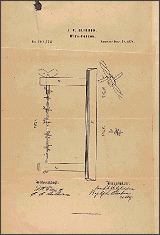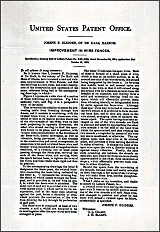
Glidden's Patent Application for Barbed Wire
Background
Life in the American West was reshaped by a series of patents for a simple tool that helped ranchers tame the land: barbed wire. Nine patents for improvements to wire fencing were granted by the U.S. Patent Office to American inventors, beginning with Michael Kelly in November 1868 and ending with Joseph Glidden in November 1874. Barbed wire not only simplified the work of the rancher and farmer, but it significantly affected political, social, and economic practices throughout the region. The swift emergence of this highly effective tool as the favored fencing method influenced life in the region as dramatically as the rifle, six-shooter, telegraph, windmill, and locomotive.
Barbed wire was extensively adopted because it proved ideal for western conditions. Vast and undefined prairies and plains yielded to range management, farming, and ultimately, widespread settlement. As the use of barbed wire increased, wide open spaces became less wide, less open, and less spacious, and the days of the free roaming cowboy were numbered. Today, cowboy ballads remain as nostalgic reminders of life before barbed wire became an accepted symbol of control, transforming space to place and giving new meaning to private property.
Before the invention of barbed wire, the lack of effective fencing limited the range of farming and ranching practices, and with it, the number of people who could settle in an area. Wooden fences were costly and difficult to acquire on the prairie and plains, where few trees grew. Lumber was in such short supply in the region that farmers were forced to build houses of sod. Likewise, rocks for stone walls—commonly found in New England—were scarce on the plains. Shrubs and hedges, early substitutes for wood and rock fencing materials, took too long to grow to become of much use in the rapidly expanding West. Barbed wire was cheaper, easier, and quicker to use than any of these other alternatives.
Without fencing, livestock grazed freely, competing for fodder and water. Where working farms existed, most property was unfenced and open to foraging cattle and sheep. Once a year, cattle owners, unhindered by fenced property lines, led their herds on long cattle drives, eventually arriving at slaughter-houses located near urban railheads for shipping convenience. The appearance of barbed wire meant the end of both the open range and the freedom of the rancher and cowboy, an event lamented in the Cole Porter song "Don't Fence Me In."
Wire fences used before the invention of the barb consisted of only one strand of wire, which was constantly broken by the weight of cattle pressing against it. Michael Kelly made a significant improvement to wire fencing with an invention that "twisted two wires together to form a cable for barbs—the first of its kind in America," according to Henry D. and Frances T. McCallum, the authors of The Wire That Fenced the West. Known as the "thorny fence," Kelly's double-strand design made the fence stronger, and the painful barbs taught cattle to keep their distance.
Predictably, other inventors sought to improve upon Kelly's designs; among them was Joseph Glidden, a farmer from De Kalb, IL. In 1873 and 1874, patents were issued for various designs to strengthen Kelly's invention, but the recognized winner in this series of improvements was Glidden's simple wire barb locked onto a double-strand wire. Glidden's invention made barbed wire more effective not only because he described a method for locking the barbs in place, but also because he developed the machinery to mass-produce the wire. His invention also survived court challenges from other inventors. Glidden's patent, prevailing in both litigation and sales, was soon known as "the winner." Today, it remains the most familiar style of barbed wire.
The widespread use of barbed wire changed life on the Great Plains dramatically and permanently. Land and water once open to all was fenced off by ranchers and homesteaders with predictable results. Cattlemen, increasingly cut off from what they regarded as common-use resources in such territories as Texas, New Mexico, Colorado, and Wyoming, first filed land-use petitions and then waged fierce range wars against the property-owning farmers. Gradually, there was a discernible shift in who controlled the land and thus wielded the superior power.
Living patterns of nomadic Native Americans were radically altered, as well. Further squeezed from lands they had always used, they began calling barbed wire "the Devil's rope." Fenced-off land meant that more and more cattle herders—regardless of race—were dependent on the dwindling public lands, which rapidly became overgrazed. The harsh winter of 1886, culminating in a big January 1887 blizzard, wreaked further havoc on the cattle market: losses totaled more than $20 million in Wyoming alone. In effect, large-scale, open-range cattle enterprises disappeared.
While barbed wire symbolized the range wars and the end of widespread open grazing land for livestock in the American West, it also became a widely used commodity elsewhere, especially during land warfare. In early European history, pointed spears or palisades circumferentially surrounded many castles for protection. Barbed wire rapidly replaced these and other devices used to protect people and property from unwanted intrusion. Military usage of barbed wire formally dates to 1888, when British military manuals first encouraged its use.
During the Spanish American War, Teddy Roosevelt's Rough Riders chose to defend their camps with the help of barbed wire. In turn-of-the-century South Africa, five-strand fences were linked to blockhouses sheltering British troops from the encroachment of Boer commandos. During World War I, barbed wire was used as a military weapon. It was a formidable barrier along the front, stretching from Switzerland to the English Channel. Even now, barbed wire is widely used to protect and safeguard military installations and to establish territorial boundaries. It has also emerged as a commonly recognized instrument for prisoner confinement; the image of a corpse caught on the wires of a concentration camp fence has become the emblem of war's ravages. Today, barbed wire is often part of the containment wall of prisons all over the world.
Other less emotionally charged uses of barbed wire fencing exist in industry. Used on construction and storage sites and around warehouses, barbed wire protects supplies and persons and keeps out unwanted intruders. In any event, it has proved both highly useful and highly significant in altering traditional practices during both war and peace.
Glidden's patent, No. 157124, was issued November 24, 1874.
The Documents
Patent Drawing
National Archives and Records Administration
Records of the Patent and Trademark Office
Record Group 241
Patent Description
National Archives and Records Administration
Records of the Patent and Trademark Office
Record Group 241
Article Citation
Ray, Emily and Wynell Schamel. "Glidden's Patent Application for Barbed Wire." Social Education 61, 1 (January 1997): 52-55.

